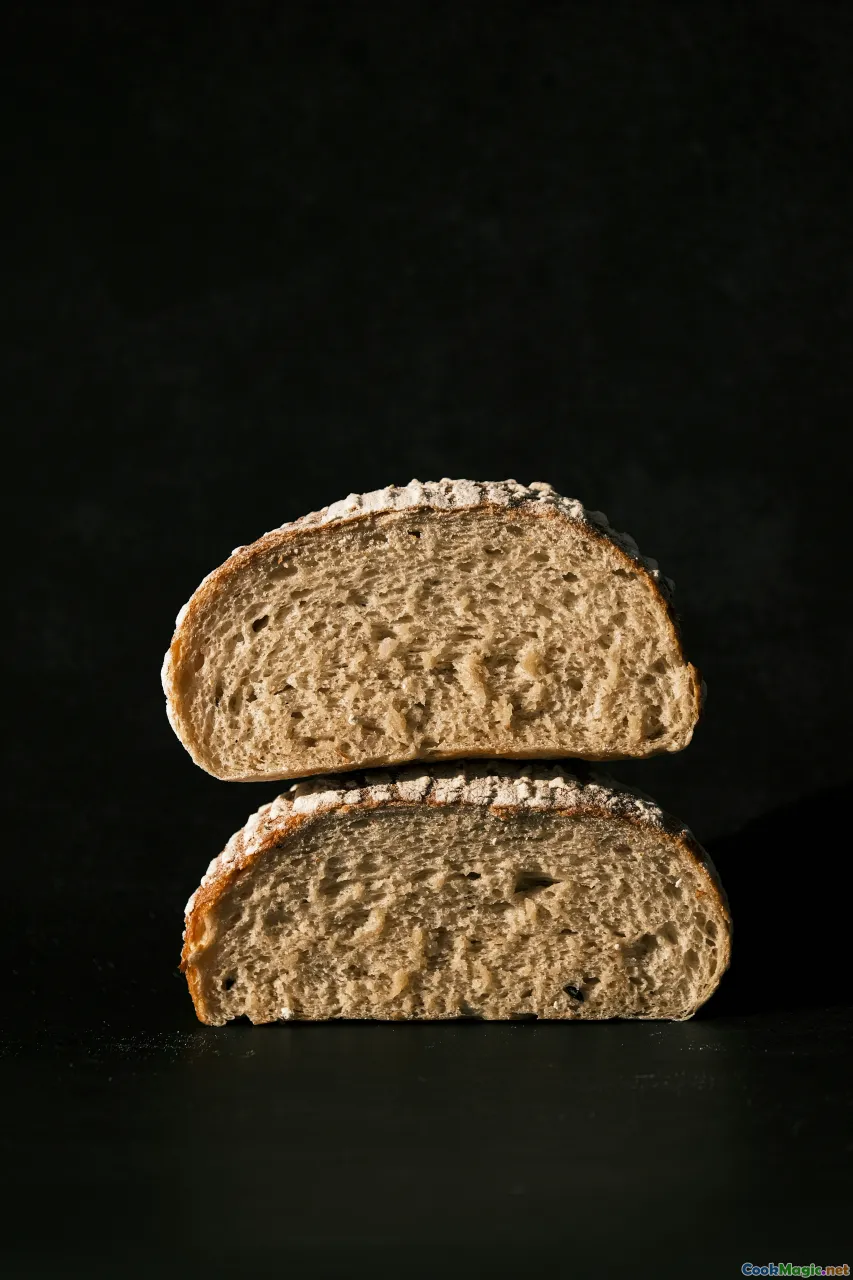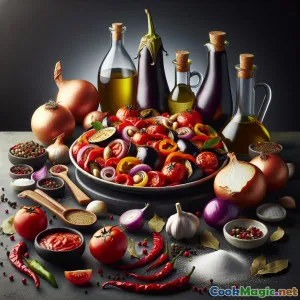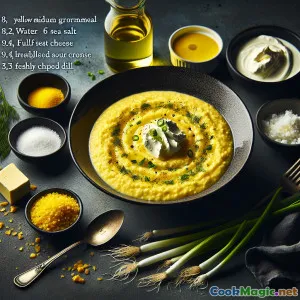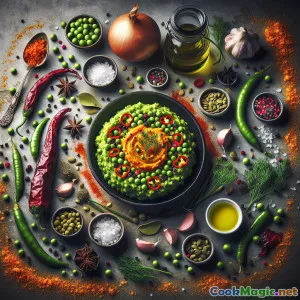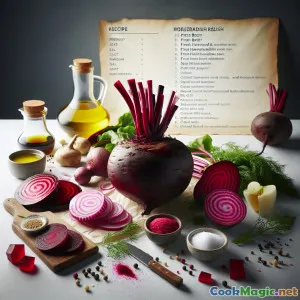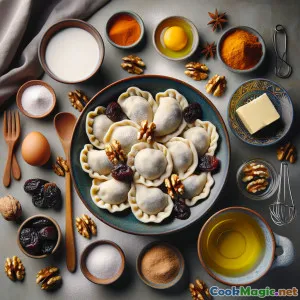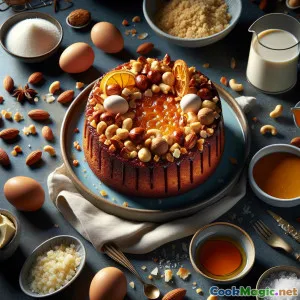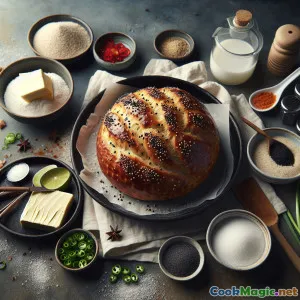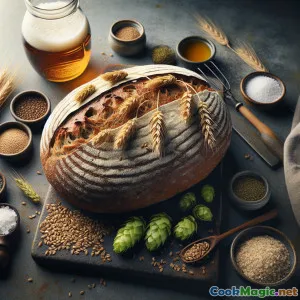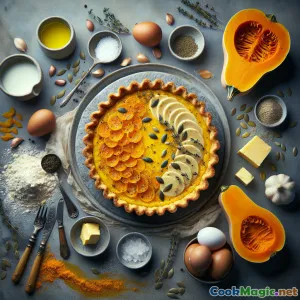
हुनेदोआरा स्पेल्ट ब्रेड: एक देहाती रोमानियाई रोटी
(Hunedoara Spelt Loaf: A Rustic Romanian Bread)
(0 समीक्षाएँ)सामग्री
-
500 grams स्पेल्ट आटा
(Use whole spelt flour for best results.)
-
350 ml गर्म पानी
(Approximately 40°C/104°F, adjust as needed.)
-
7 grams सक्रिय सूखी खमीर
(One standard sachet.)
-
1 tbsp स्थानीय जंगली फूलों का शहद
(Adds subtle aroma and feeds the yeast.)
-
10 grams मिश्रित समुद्री नमक
(Enhances flavor, don't reduce.)
-
40 grams सुनफ्लावर बीज
(For topping and subtle crunch.)
-
15 ml जैतून का तेल
(Greasing the bowl and loaf tin.)
(Use whole spelt flour for best results.)
(Approximately 40°C/104°F, adjust as needed.)
(One standard sachet.)
(Adds subtle aroma and feeds the yeast.)
(Enhances flavor, don't reduce.)
(For topping and subtle crunch.)
(Greasing the bowl and loaf tin.)
पोषण
- परोसने की संख्या: 10
- सेवा आकार: 1 thick slice (90g)
- Calories: 180 kcal
- Carbohydrates: 35 g
- Protein: 7 g
- Fat: 3 g
- Fiber: 4 g
- Sugar: 1.5 g
- Sodium: 250 mg
- Cholesterol: 0 mg
- Calcium: 22 mg
- Iron: 1.7 mg
निर्देश
-
1 - Activate the Yeast:
Mix the warm water, honey, and yeast in a large bowl. Let the mixture sit for 10 minutes, until foamy on top.
-
2 - Combine Dry Ingredients:
In another bowl, whisk together the spelt flour and salt. Optionally, reserve a handful of sunflower seeds for the topping.
-
3 - Make the Dough:
Gradually add the dry mix into the yeast mixture. Stir until a shaggy dough forms. If using, mix in most sunflower seeds.
-
4 - Knead and First Rise:
Turn dough onto a lightly floured surface and knead it for about 7–8 minutes until smooth. Place in an oiled bowl; cover and let rise in a warm place for 1 hour, or until doubled.
-
5 - Shape the Loaf:
Punch down the dough, shape into a loaf, and transfer to an oiled 900g (2lb) loaf tin. Sprinkle reserved sunflower seeds on top for extra crunch.
-
6 - Second Rise:
Cover loosely and let rise again in the tin for about 30–40 minutes, until it domes over the rim.
-
7 - Bake the Bread:
Preheat oven to 220°C (430°F). Bake the loaf on the middle rack. After 10 minutes, reduce heat to 200°C (390°F) and continue baking for 40 minutes until golden and it sounds hollow when tapped.
-
8 - Cool and Slice:
Remove loaf from tin and cool completely on a rack before slicing to preserve crumb texture and moisture.
Mix the warm water, honey, and yeast in a large bowl. Let the mixture sit for 10 minutes, until foamy on top.
In another bowl, whisk together the spelt flour and salt. Optionally, reserve a handful of sunflower seeds for the topping.
Gradually add the dry mix into the yeast mixture. Stir until a shaggy dough forms. If using, mix in most sunflower seeds.
Turn dough onto a lightly floured surface and knead it for about 7–8 minutes until smooth. Place in an oiled bowl; cover and let rise in a warm place for 1 hour, or until doubled.
Punch down the dough, shape into a loaf, and transfer to an oiled 900g (2lb) loaf tin. Sprinkle reserved sunflower seeds on top for extra crunch.
Cover loosely and let rise again in the tin for about 30–40 minutes, until it domes over the rim.
Preheat oven to 220°C (430°F). Bake the loaf on the middle rack. After 10 minutes, reduce heat to 200°C (390°F) and continue baking for 40 minutes until golden and it sounds hollow when tapped.
Remove loaf from tin and cool completely on a rack before slicing to preserve crumb texture and moisture.
हुनेदोआरा स्पेल्ट ब्रेड: एक देहाती रोमानियाई रोटी :के बारे में ज़्यादा जानकारी
Hunedoara Spelt Bread Loaf: A Culinary Homage to Romania's Traditions
Hunedoara, located in the heart of Transylvania in Romania, is renowned for its bucolic countryside, medieval castles, and centuries-old bread-making traditions. In this uniquely crafted recipe, we reimagine the regional loaves by using ancient spelt, a type of whole grain that dates back to medieval times. Highly revered for its slight nutty flavor, lower gluten content, and wholesome nutrition, spelt flour breathes rustic originality into each slice of this bread.
A Journey Through Time with Spelt
Spelt (Triticum spelta) is a cousin of modern wheat that's experiencing a well-deserved renaissance in artisan baking. Prized amongst both home bakers and specialty bakeries across Europe, spelt has its roots intertwined with the spread of agriculture into the Carpathian basin more than 7000 years ago. Locals in modern Romania have been hand-shaping loaves on stone hearths using heirloom grains for generations—imbuing every bake with a sense of place and heritage. The earthy character of spelt, combined with its relatively easy digestibility, makes it a wonderful foundation for a simple, yet flavorful bread.
The Ingredients, Explained
This recipe pays tribute to regional tastes by utilizing just seven accessible ingredients. The spelt flour is the true backbone; its micro-nutrient profile and flavors are slightly different from modern wheat, meaning it needs a bit less kneading and a careful touch when hydrating. Warm water activates the yeast and gently wakes up the flour, while a splash of honey reflects both the flavors and the folklore—Transylvania is renowned for perfumed wildflower honey, often associated with healing and fertility in local lore. Salt is non-negotiable, amplifying all the complex notes of the grain. Sunflower seeds, once an occasional filler in rural loaves, are sprinkled here for their nutty crunch and visual welcome.
Inspired by Tradition, Infused with Modern Simplicity
Very little in this recipe is complicated—bread was, and still is, the food of everyman and daily labor. Even in the digital age, its essence hasn’t changed: dough, patience, and the magical moment it transforms under high heat. Using just one good rise (and sometimes two, for superior texture), spelt offers up a tender, flavorful crumb and craggy exterior without the chewiness or tight crumb of wheat. If you’re sensitive to gluten, many find spelt easier to digest (though it’s not appropriate for celiac disease).
Pro Tips & Notes
- Be cautious not to over-knead spelt; its gluten is more fragile than regular wheat.
- The loaf freezes exceptionally well—slice before freezing for easy mornings.
- Try mixing other seeds into the dough: pumpkin or flax add extra nutrition.
- Serve as is, toast thickly with herbal spreads, or alongside robust stews—a common practice in Hunedoara during long winters.
- For a crisper crust, introduce steam by placing a pan of water in the oven’s first 15 minutes.
History and Cultural Insight
Throughout Hunedoara, especially near the fabled Corvin Castle, bread annually holds ceremonial roles, gifted during festivals or weddings to symbolize bounty. Traditionally, whole grains reflect prosperity and offer a piece of ancestral wisdom—food should nourish as much as delight. Breads mirror the land; by using spelt flour, this recipe taps into the historic grain exchanges that once fueled caravans along the Danube and through arched Transylvanian passes. Every bite humbly honors generations bonding over slow fermentation and wood-fired flavor.
Final Thoughts
Hunedoara Spelt Bread Loaf isn’t just a recipe—it’s an edible artifact, merging the hands of artisans past and innovators present. Simple, nourishing, and unpretentious, its every slice invokes floury linen aprons, twilight chats by stone ovens, and a deeply felt sense of home. Experiment gently, respect the dough, and let local flavor inspire how you share the old world at your new table.


